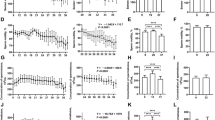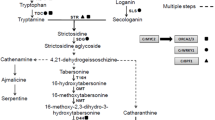Abstract
Cadmium (Cd) is a kind of toxic heavy metal and it can cause damage to organs and tissues. Selenium (Se) can antagonize some metal element toxicity including Cd. The present study was designed to investigate Cd-induced damage to chicken ovary by autophagy and the protective mechanism of Se on Cd-induced damage. Administration of Cd for 12 weeks led to energy metabolism disorder of the chicken ovarian tissues, which resulted in autophagy. In addition, the mRNA expression of glucose-related genes including hexokinase II (HK2), pyruvate kinase (PK), pyruvate dehydrogenase complex (PDHX), and succinate dehydrogenase (SDH) and the activities of ATPase, including Na+-K+-ATPase, Ca2+-ATPase, Mg2+-ATPase, were all downregulated remarkably compared with the control. However, combined with oral administration of Se at 2 mg/kg, the mRNA expression of glucose-related genes and the activities of ATPase increased. The mRNA expression of the autophagy-related genes by Cd treatment, including microtubule-associated protein light chain 3 (LC3), dynein, autophagy-related gene 5 (Atg5), and Beclin 1, was remarkably enhanced, whereas mammalian target of rapamycin (mTOR) was downregulated. However, besides mTOR, their levels displayed a downregulated trend beyond simultaneous Se treatment. The protein expression of autophagy genes was similar to those of mRNA. In conclusion, Cd toxicity affect energy metabolism and induce autophagy, which causes damage to chicken ovary, whereas Se could protect effectively this injury induced by Cd.





Similar content being viewed by others
Abbreviations
- Cd:
-
Cadmium
- Se:
-
Selenium
- HK2:
-
Hexokinase II
- PK:
-
Pyruvate kinase
- PDHX:
-
Pyruvate dehydrogenase complex
- SDH:
-
Succinate dehydrogenase
- LC3:
-
Microtubule-associated protein light chain 3
- mTOR:
-
Mammalian target of rapamycin
- Atg5:
-
Autophagy-related gene 5
- q-PCR:
-
Quantitative real-time polymerase chain reaction
References
Koyu A, Gokcimen A, Ozguner F, Bayram DS, Kocak A (2006) Evaluation of the effects of cadmium on rat liver. Mol Cell Biochem 284(1):81–85
Thijssen S, Maringwa J, Faes C, Lambrichts I, Van KE (2007) Chronic exposure of mice to environmentally relevant, low doses of cadmium leads to early renal damage, not predicted by blood or urine cadmium levels. Toxicology 229(1–2):145–156
Saksena SK, Dahlgren L, Lau IF, Chang MC (1977) Reproductive and endocrinological features of male rats after treatment with cadmium chloride. Biol Reprod 16(5):609–613
Haouem S, Hmad N, Najjar MF, El HA, Sakly R (2007) Accumulation of cadmium and its effects on liver and kidney functions in rats given diet containing cadmium-polluted radish bulb. Exp Toxicol Pathol Off J Gesellschaft Für Toxikologische Pathologie 59(1):77–80
Kluxen FM, Höfer N, Kretzschmar G, Degen GH, Diel P (2012) Cadmium modulates expression of aryl hydrocarbon receptor-associated genes in rat uterus by interaction with the estrogen receptor. Arch Toxicol 86(4):591–601
Zhang W, Pang F, Huang Y, Yan P, Lin W (2008) Cadmium exerts toxic effects on ovarian steroid hormone release in rats. Toxicol Lett 182(1–3):18–23
Höfer N, Diel P, Wittsiepe J, Wilhelm M, Degen GH (2009) Dose- and route-dependent hormonal activity of the metalloestrogen cadmium in the rat uterus. Toxicol Lett 191(2–3):123–131
Sheng Y, Sun B, Guo WT, Zhang YH, Liu X, Xing Y, Dong DL (2013) 3-Methyladenine induces cell death and its interaction with chemotherapeutic drugs is independent of autophagy. Biochem Biophys Res Commun 432(1):5–9
Xue L, Fletcher GC, Tolkovsky AM (1999) Autophagy is activated by apoptotic signalling in sympathetic neurons: an alternative mechanism of death execution. Mol Cellu Neurosci 14(3):180–198
Lim SC, Hahm KS, Lee SH, Oh SH (2010) Autophagy involvement in cadmium resistance through induction of multidrug resistance-associated protein and counterbalance of endoplasmic reticulum stress WI38 lung epithelial fibroblast cells. Toxicology 276(1):18–26
Chen M, Li X, Fan R, Yang J, Jin X, Hamid S, Xu S (2017) Cadmium induces BNIP3-dependent autophagy in chicken spleen by modulating miR-33-AMPK axis. Chemosphere 194:396–402
Eisenberglerner A, Kimchi A (2009) The paradox of autophagy and its implication in cancer etiology and therapy. Apoptosis 14(4):376–391
Woods A, Heath R, Dickerson K, Hong SP, Momcilovic M, Johnstone SR, Carlson M, Carling D (2005) Ca2+/calmodulin-dependent protein kinase kinase-beta acts upstream of AMP-activated protein kinase in mammalian cells. Cell Metab 2(1):21–33
Mizushima N (2004) Role of Bcl-2 family proteins in a non-apoptotic programmed cell death dependent on autophagy genes. Nat Cell Biol 6(6):1221–1228
Wang SH, Shih YL, Kuo TC, Ko WC, Shih CM (2009) Cadmium toxicity toward autophagy through ROS-activated GSK-3β in mesangial cells. Toxicol Sci 108(1):124–131
Dong Z, Wang L, Xu J, Li Y, Zhang Y, Zhang S, Miao J (2009) Promotion of autophagy and inhibition of apoptosis by low concentrations of cadmium in vascular endothelial cells. Toxicol in Vitro 23(1):105–110
Ramírez-Peinado S, León-Annicchiarico C, Iurlaro R, Muñoz-Pinedo C (2012) Cell death induced by inhibition of glucose metabolism: role of Bcl-2 proteins and autophagy. Exp Clin Endocrinol Diabetes 120(10):567–638
Moruno-Manchón JF, Pérez-Jiménez E, Knecht E (2013) Glucose induces autophagy under starvation conditions by a p38 MAPK-dependent pathway. Biochem J 449(2):497–506
Lock R, Roy S, Kenific CM, Su JS, Salas E, Ronen SM, Debnath J (2011) Autophagy facilitates glycolysis during Ras-mediated oncogenic transformation. Mol Biol Cell 22(2):165–178
Yao HD, Wu Q, Zhang ZW, Zhang JL, Li S, Huang JQ, Ren FZ, Xu SW, Wang XL, Lei XG (2013) Gene expression of endoplasmic reticulum resident selenoproteins correlates with apoptosis in various muscles of se-deficient chicks. J Nutr 143(5):613–619
El-Sharaky AS, Newairy AA, Badreldeen MM, Eweda SM, Sheweita SA (2007) Protective role of selenium against renal toxicity induced by cadmium in rats. Toxicology 235(3):185–193
Yao H, Liu W, Zhao W, Fan R, Zhao X, Khoso PA, Zhang Z, Xu S (2014) Different responses of selenoproteins to the altered expression of selenoprotein W in chicken myoblasts. RSC Adv 4(109):64032–64042
Li X, Xing M, Chen M, Zhao J, Fan R, Xia Z, Cao C, Jie Y, Zhang Z, Xu S (2017) Effects of selenium-lead interaction on the gene expression of inflammatory factors and selenoproteins in chicken neutrophils. Ecotoxicol Environ Safety 139:447–453
Jin X, Xu Z, Zhao X, Chen M, Xu S (2017) The antagonistic effect of selenium on lead-induced apoptosis via mitochondrial dynamics pathway in the chicken kidney. Chemosphere 180:259–266
Yao HD, Wu Q, Zhang ZW, Shu L, Wang XL, Lei XG, Xu SW (2013) Selenoprotein W serves as an antioxidant in chicken myoblasts. Biochim Biophys Acta 1830(4):3112–3120
Messaoudi I, El HJ, Hammouda F, Saïd K, Kerkeni A (2009) Protective effects of selenium, zinc, or their combination on cadmium-induced oxidative stress in rat kidney. Biol Trace Elem Res 130(2):152–161
Ognjanovic B, Markovic S, Pavlovic S, Zikic R, As SZ (2008) Effect of chronic cadmium exposure on antioxidant defense system in some tissues of rats: protective effect of selenium. Physiol Res 57(3):403–411
Lazarus M, Orct T, Jurasoviæ J, Blanuša M (2009) The effect of dietary selenium supplementation on cadmium absorption and retention in suckling rats. Biometals 22(6):973–983
Pappas AC, Zoidis E, Georgiou CA, Demiris N, Surai PF, Fegeros K (2011) Influence of organic selenium supplementation on the accumulation of toxic and essential trace elements involved in the antioxidant system of chicken. Food Addit Contam Part A Chem Anal Control Exposure Risk Assess 28(4):446–454
Alwaeli A, Zoidis E, Pappas AC, Demiris N, Zervas G, Fegeros K (2013) The role of organic selenium in cadmium toxicity: effects on broiler performance and health status. Animal 7(3):386–393
Pinto A, Juniper DT, Sanil M, Morgan L, Clark L, Sies H, Rayman MP, Steinbrenner H (2012) Supranutritional selenium induces alterations in molecular targets related to energy metabolism in skeletal muscle and visceral adipose tissue of pigs. J Inorg Biochem 114(9):47–54
Liu C, Fu J, Liu C, Li S (2015) The role of nitric oxide and autophagy in liver injuries induced by selenium deficiency in chickens. RSC Adv 5(62):50549–50556
Frustaci A, Sabbioni E, Fortaner S, Farina M, Torchio RD, Tafani M, Morgante E, Ciriolo MR, Russo MA, Chimenti C (2012) Selenium- and zinc-deficient cardiomyopathy in human intestinal malabsorption: preliminary results of selenium/zinc infusion. Eur J Heart Fail 14(2):202–210
Tan S, Chi Q, Liu T, Sun Z, Min Y, Zhang Z, Shu L (2017) Alleviation mechanisms of selenium on cadmium-spiked neutrophil injury to chicken. Biol Trace Elem Res 178:301–309
Wang L, Li J, Li J, Liu Z (2010) Effects of lead and/or cadmium on the oxidative damage of rat kidney cortex mitochondria. Biol Trace Elem Res 137(1):69–78
Krstić D, Krinulović K, Vasić V (2005) Inhibition of Na+-K+-ATPase and Mg2+-ATPase by metal ions and prevention and recovery of inhibited activities by chelators. J Enzyme Inhib Med Chem 20(5):469–476
Kim H, Lim B, Kim BD, Lee YM (2016) Effects of heavy metals on transcription and enzyme activity of Na+-K+-ATPase in the monogonont rotifer, Brachionus koreanus. Toxicol Environ Heal Sci 8(2):128–134
Canesi L, Ciacci C, Piccoli G, Stocchi V, Viarengo A, Gallo G (1998) In vitro and in vivo effects of heavy metals on mussel digestive gland hexokinase activity: the role of glutathione. Comp Biochem Physiol C: Pharmacol Toxicol Endocrinol 120(2):261–268
Pysher MD, Sollome JJ, Regan S, Cardinal TR, Hoying JB, Brooks HL, Vaillancourt RR (2007) Increased hexokinase II expression in the renal glomerulus of mice in response to arsenic. Toxicol Appl Pharmacol 224(1):39–48
Lin G, Andrejeva G, Ac WTF, Hill DK, Orton MR, Parkes HG, Koh DM, Robinson SP, Leach MO, Eykyn TR (2014) Reduced Warburg effect in cancer cells undergoing autophagy: steady-state 1H-MRS and real-time hyperpolarized 13C-MRS studies. PLoS One 9(3):e92645
Liu Y, Shoji-Kawata S, Jr SR, Wei Y, Ginet V, Zhang L, Posner B, Tran KA, Green DR, Xavier RJ (2013) Autosis is a Na+-K+-ATPase-regulated form of cell death triggered by autophagy-inducing peptides, starvation, and hypoxia-ischemia. Proc Natl Acad Sci U S A 110(51):20364–20371
Z Y SJ, C Y LAJ, Heintz N (2003) Beclin 1, an autophagy gene essential for early embryonic development, is a haploinsufficient tumor suppressor. Proc Natl Acad Sci U S A 100(25):15077–15082
Cui J, Gong Z, Shen HM (2013) The role of autophagy in liver cancer: molecular mechanisms and potential therapeutic targets. Biochim Biophys Acta 1836(1):15–26
Chargui A, Zekri S, Jacquillet G, Rubera I, Ilie M, Belaid A, Duranton C, Tauc M, Hofman P, Poujeol P (2011) Cadmium-induced autophagy in rat kidney: an early biomarker of subtoxic exposure. Toxicol Sci 121(1):31–42
Zou H, Zhuo L, Han T, Hu D, Yang X, Wang Y, Yuan Y, Gu J, Bian J, Liu X (2015) Autophagy and gap junctional intercellular communication inhibition are involved in cadmium-induced apoptosis in rat liver cells. Biochem Biophys Rese Commun 459(4):713–719
Banni M, Messaoudi I, Said L, Heni JE, Kerkeni A, Said K (2010) Metallothionein gene expression in liver of rats exposed to cadmium and supplemented with zinc and selenium. Arch Environ Contam Toxicol 59(3):513–519
Taskin E, Dursun N (2015) Recovery of adriamycin induced mitochondrial dysfunction in liver by selenium. Cytotechnology 67(6):977–986
Becker DJ, Reul B, Ozcelikay AT, Buchet JP, Henquin JC, Brichard SM (1996) Oral selenate improves glucose homeostasis and partly reverses abnormal expression of liver glycolytic and gluconeogenic enzymes in diabetic rats. Diabetologia 39(1):3–11
Wang W, Zhang T, Lin H, Chang Y, Xing J (2016) Role of hydrogen sulfide on autophagy in liver injuries induced by selenium deficiency in chickens. Biol Trace Elem Res 175(1):194–203
Kumari S, Mehta SL, Li PA (2012) Glutamate induces mitochondrial dynamic imbalance and autophagy activation: preventive effects of selenium. PLoS One 7(6):e39382
Acknowledgments
The authors thank the members of the Veterinary Internal Medicine Laboratory, College of Veterinary Medicine, Northeast Agriculture University, for their help with sample collection.
Funding
This study was supported by the National Natural Science Foundation of China (Grant No.31472161) and Heilongjiang Key Laboratory for Laboratory Animals and Comparative Medicine.
Author information
Authors and Affiliations
Corresponding author
Ethics declarations
Conflict of Interest
The authors declare that they have no conflict of interest.
Additional information
All of the authors have read the manuscript and agreed to submit it in its current form for consideration for publication in the Biological Trace Element Research.
Rights and permissions
About this article
Cite this article
Wang, S., Xu, Z., Yin, H. et al. Alleviation Mechanisms of Selenium on Cadmium-Spiked in Chicken Ovarian Tissue: Perspectives from Autophagy and Energy Metabolism. Biol Trace Elem Res 186, 521–528 (2018). https://doi.org/10.1007/s12011-018-1341-y
Received:
Accepted:
Published:
Issue Date:
DOI: https://doi.org/10.1007/s12011-018-1341-y




